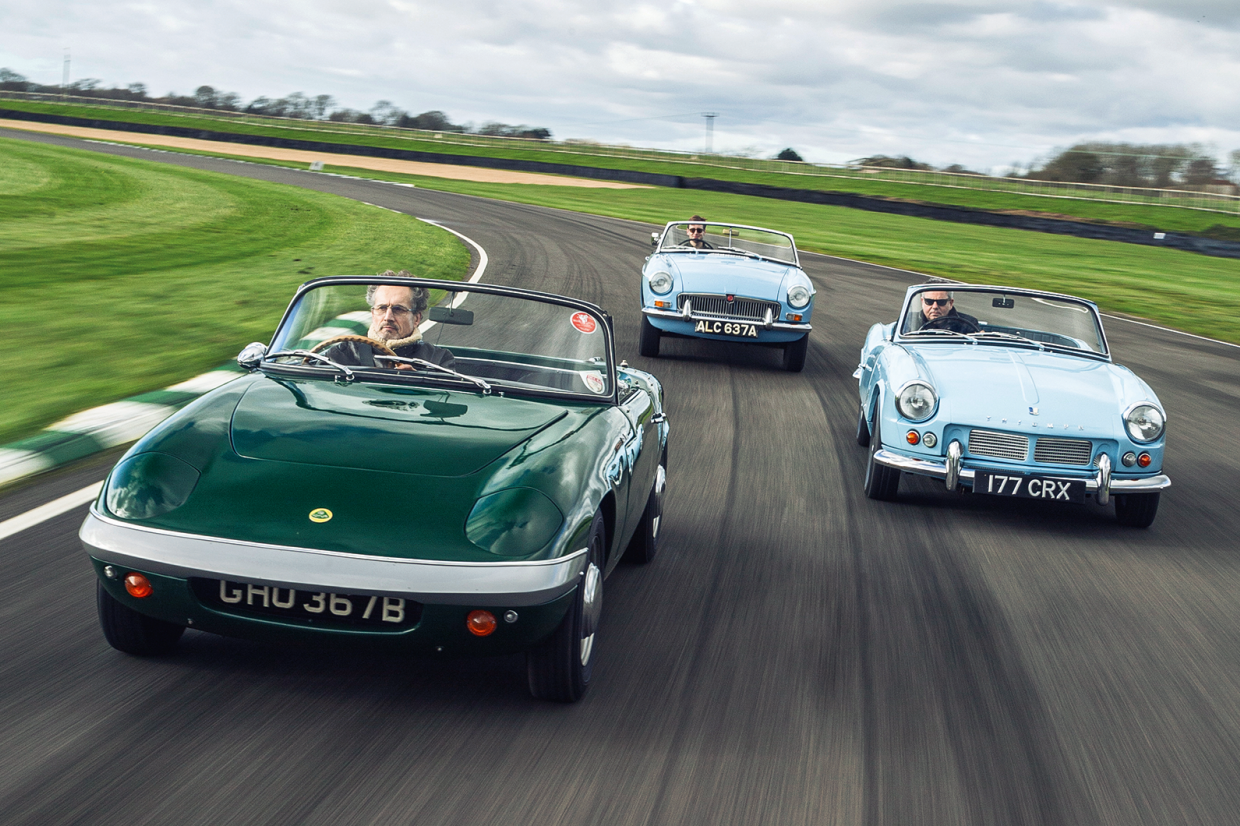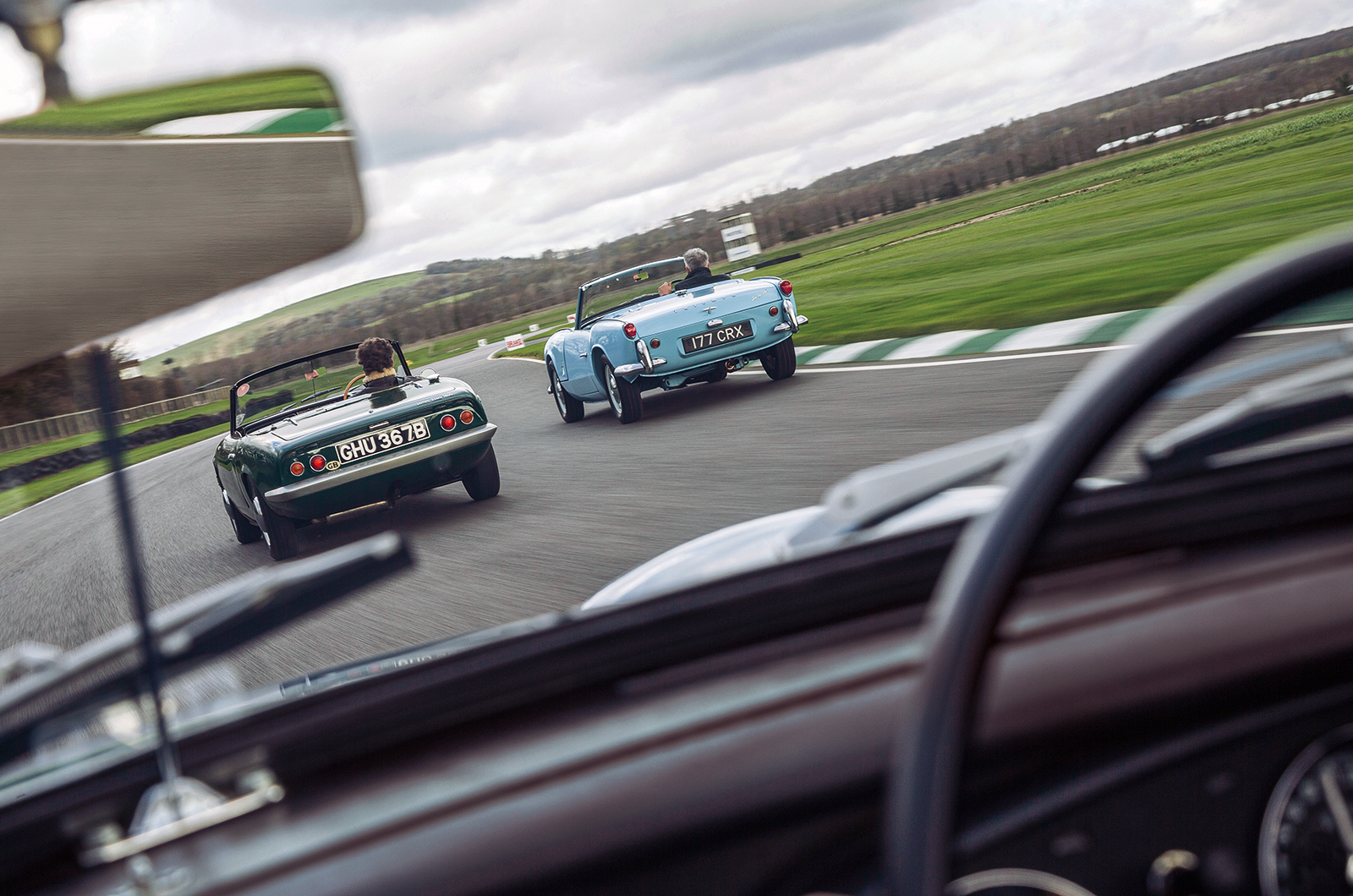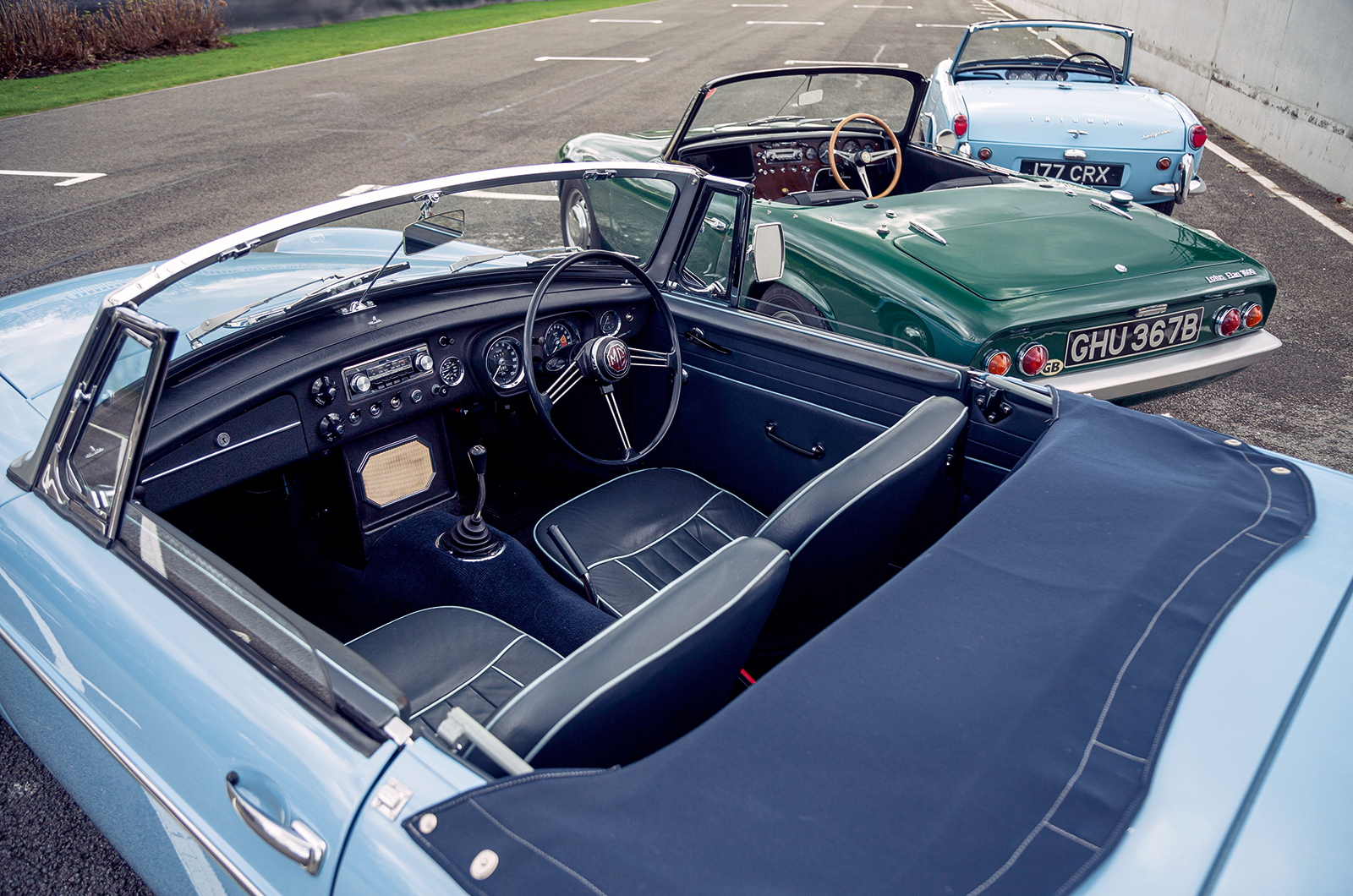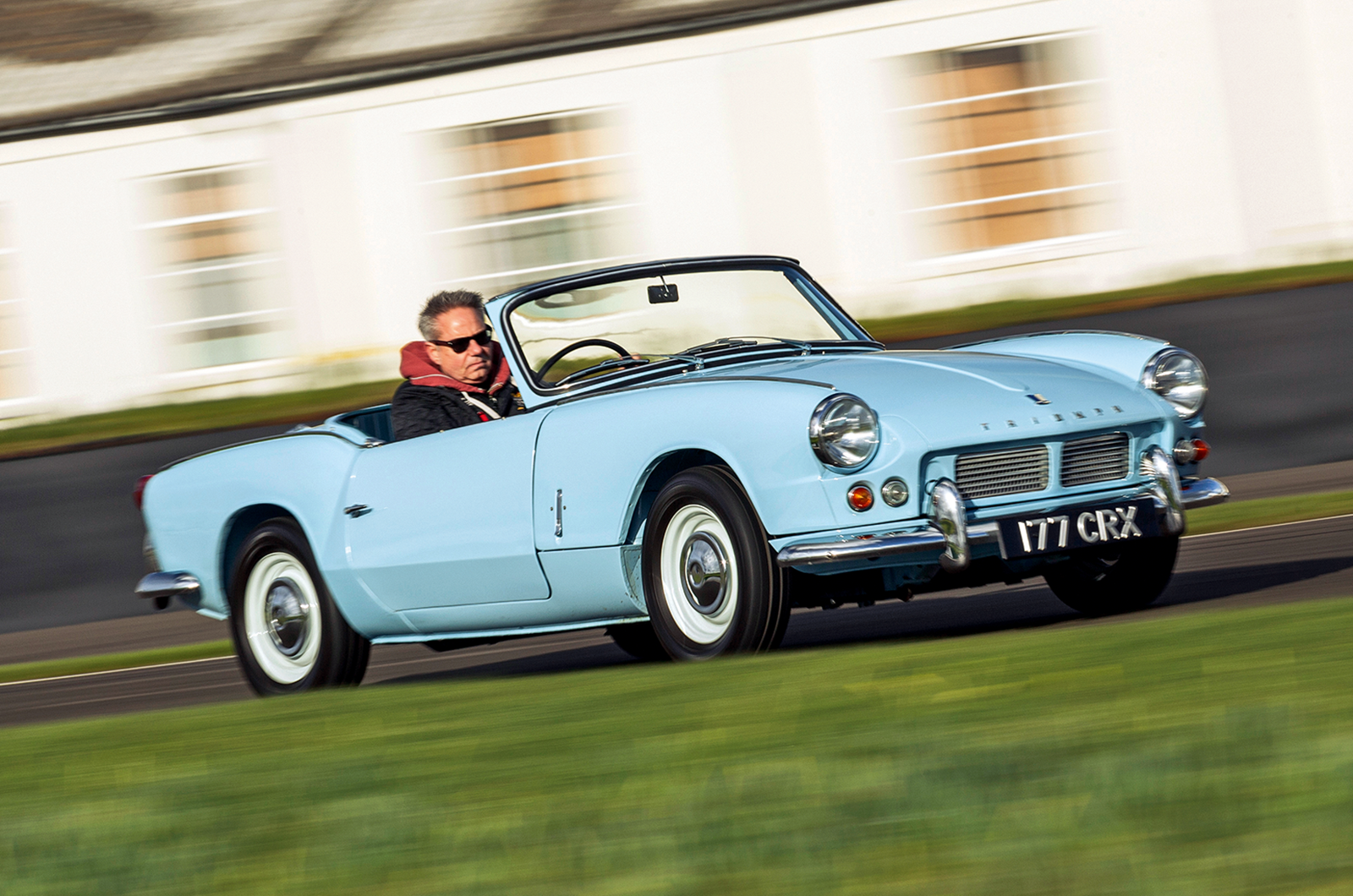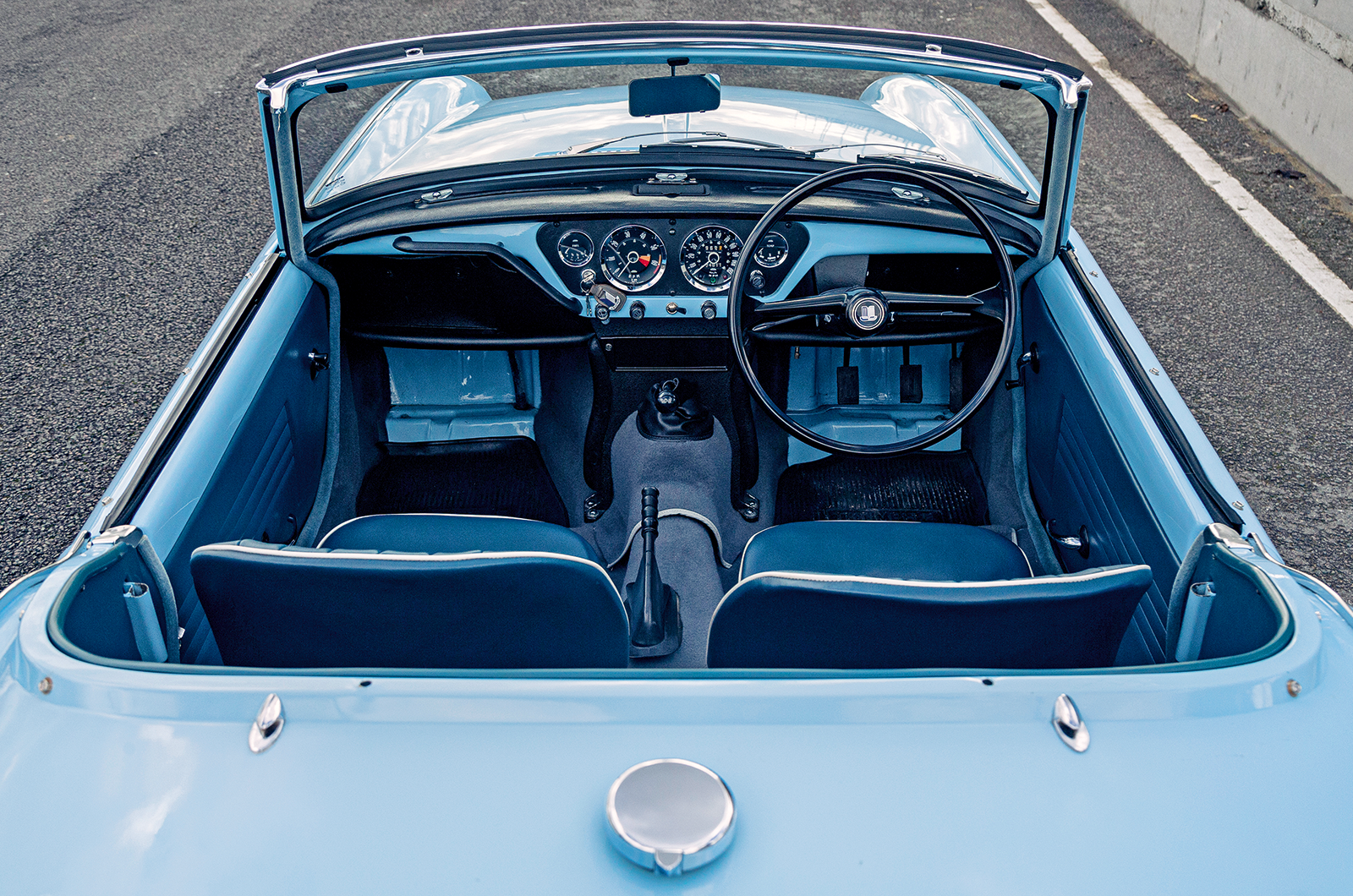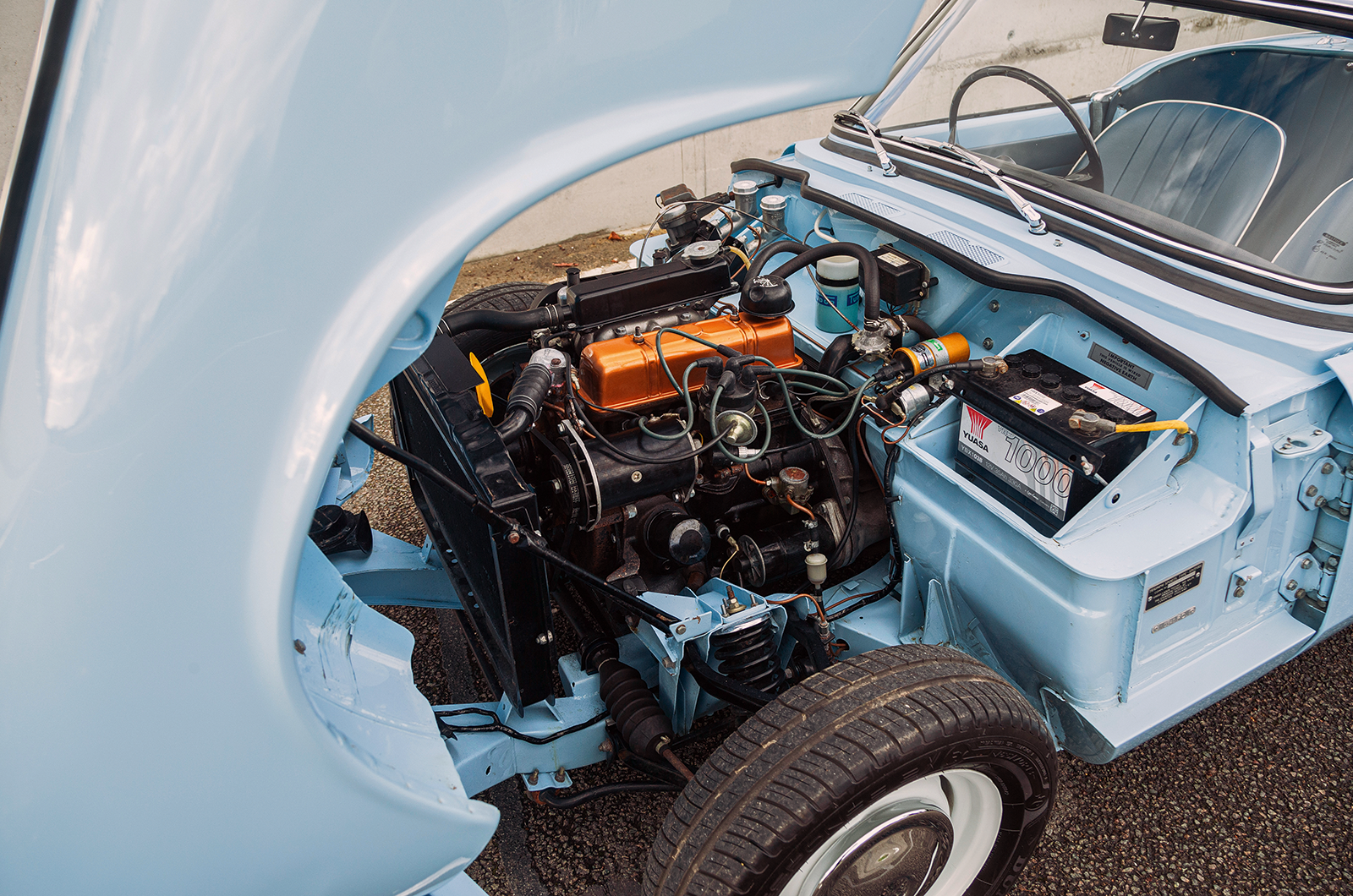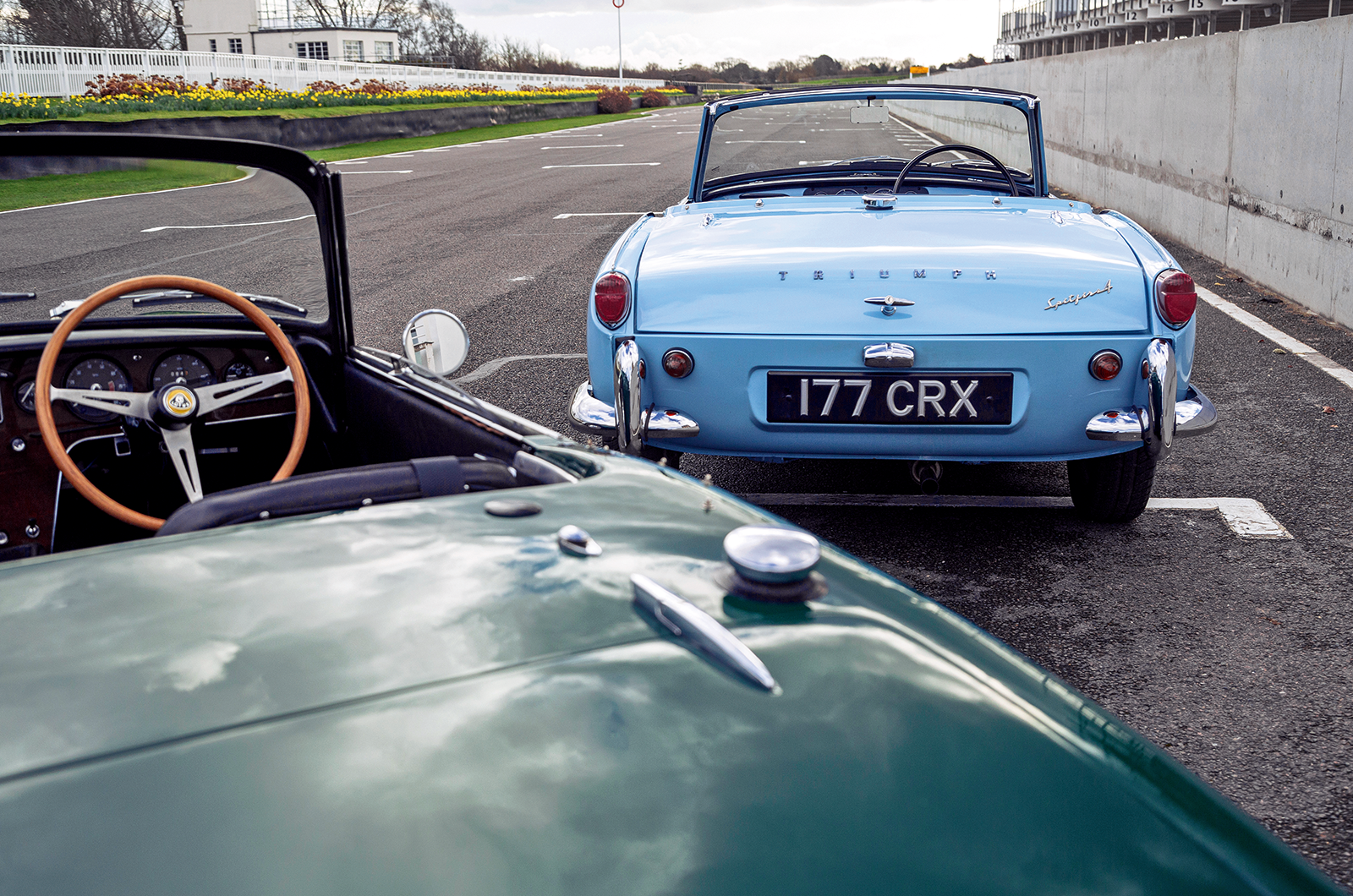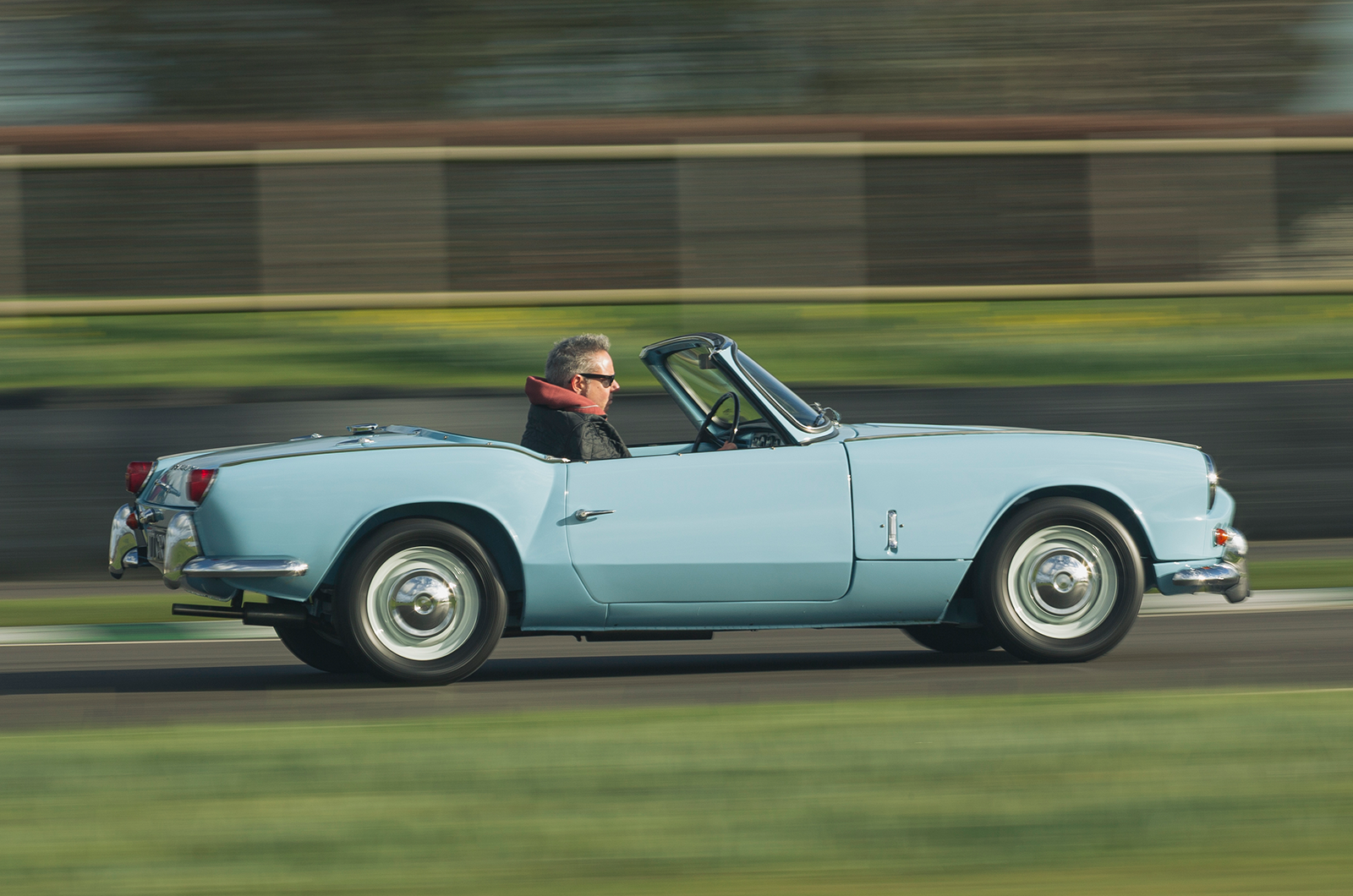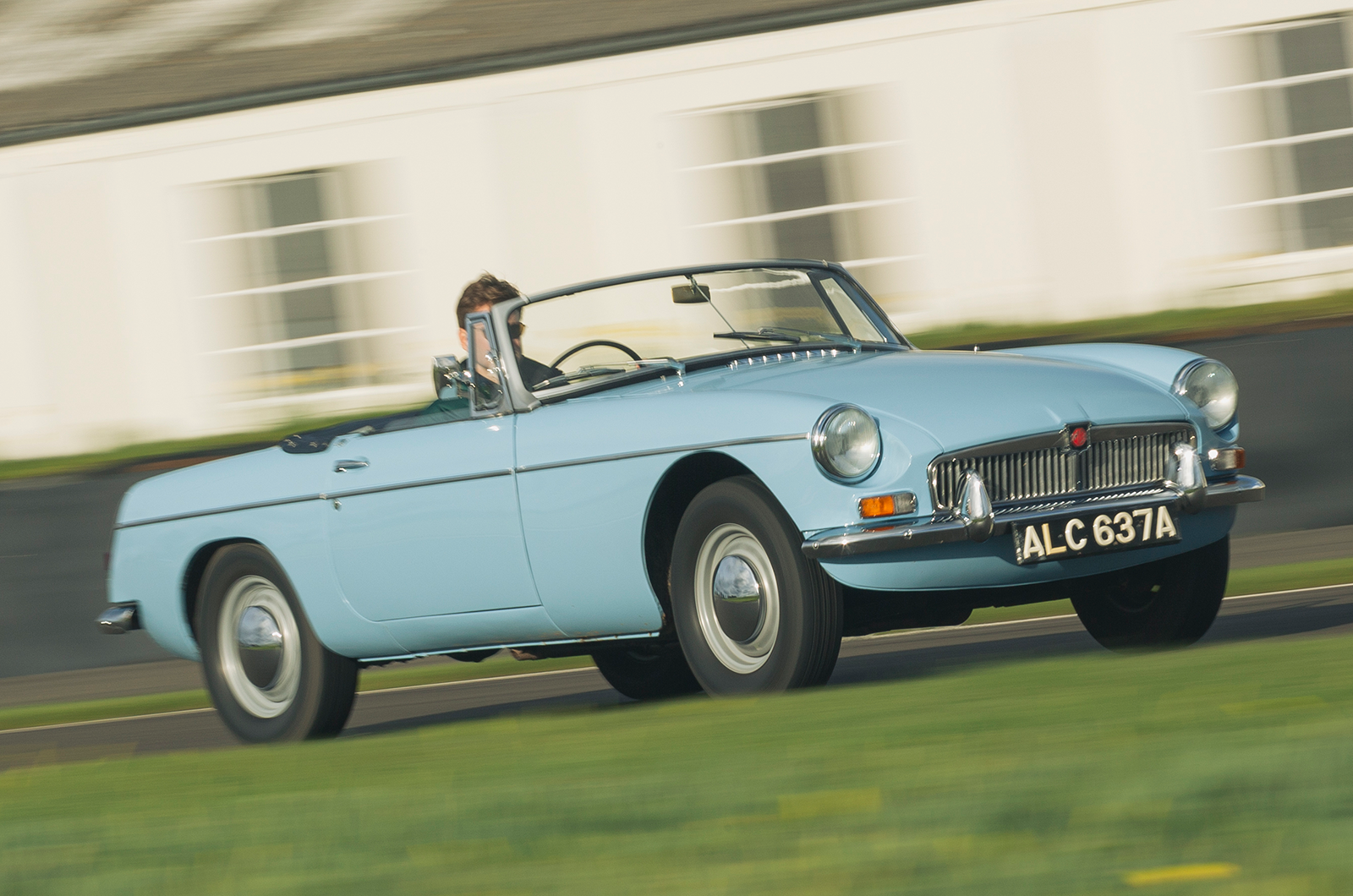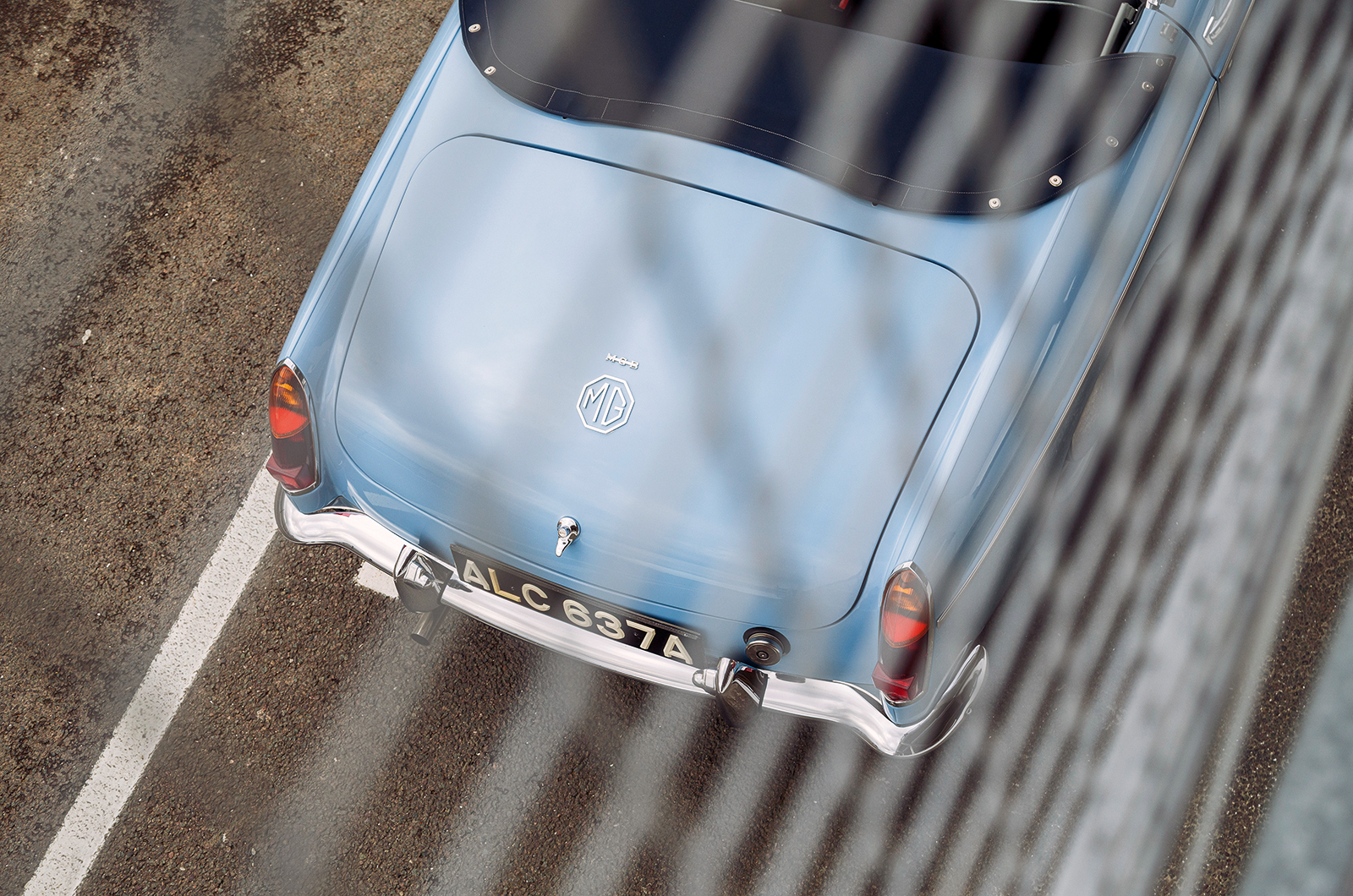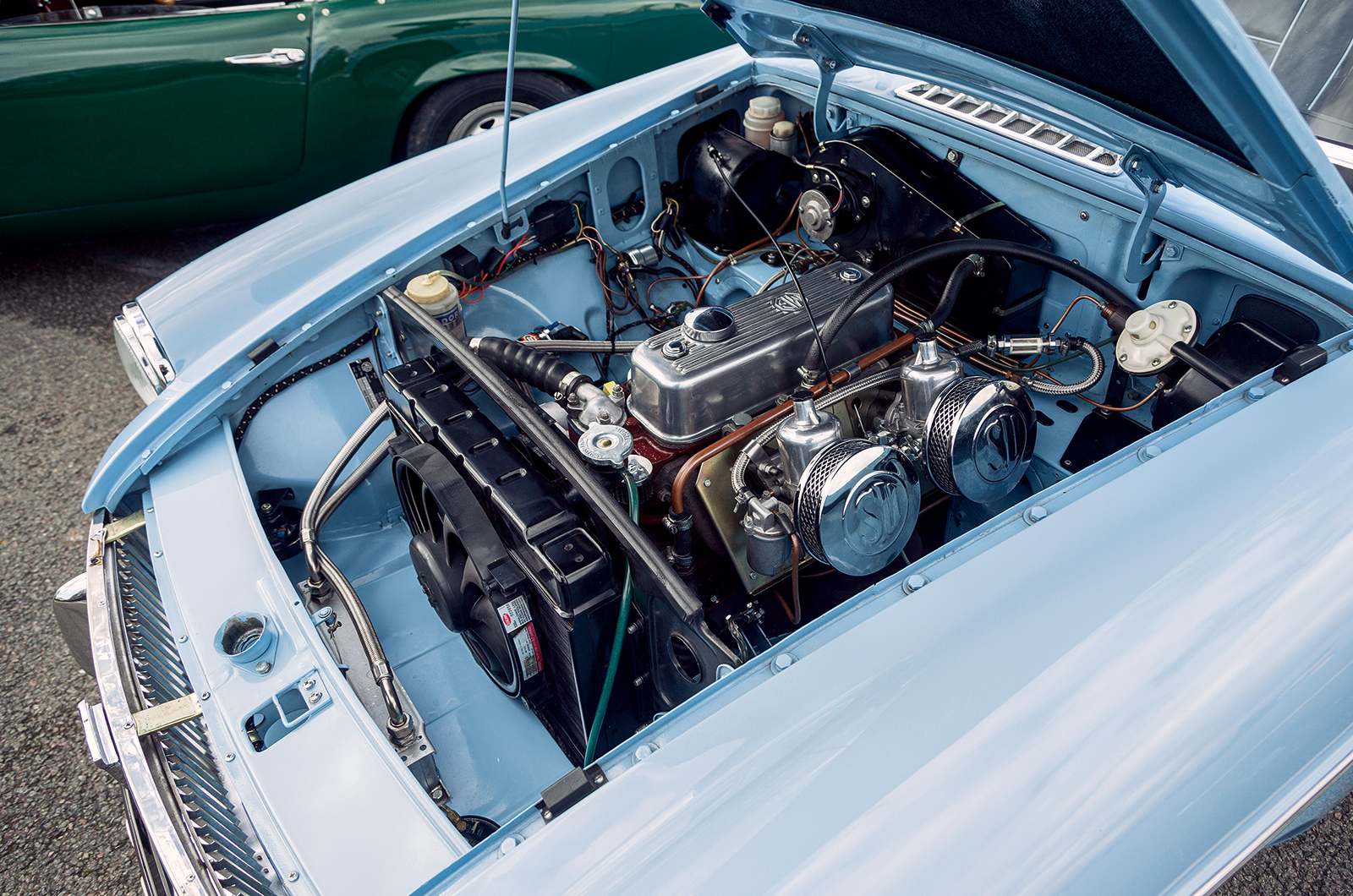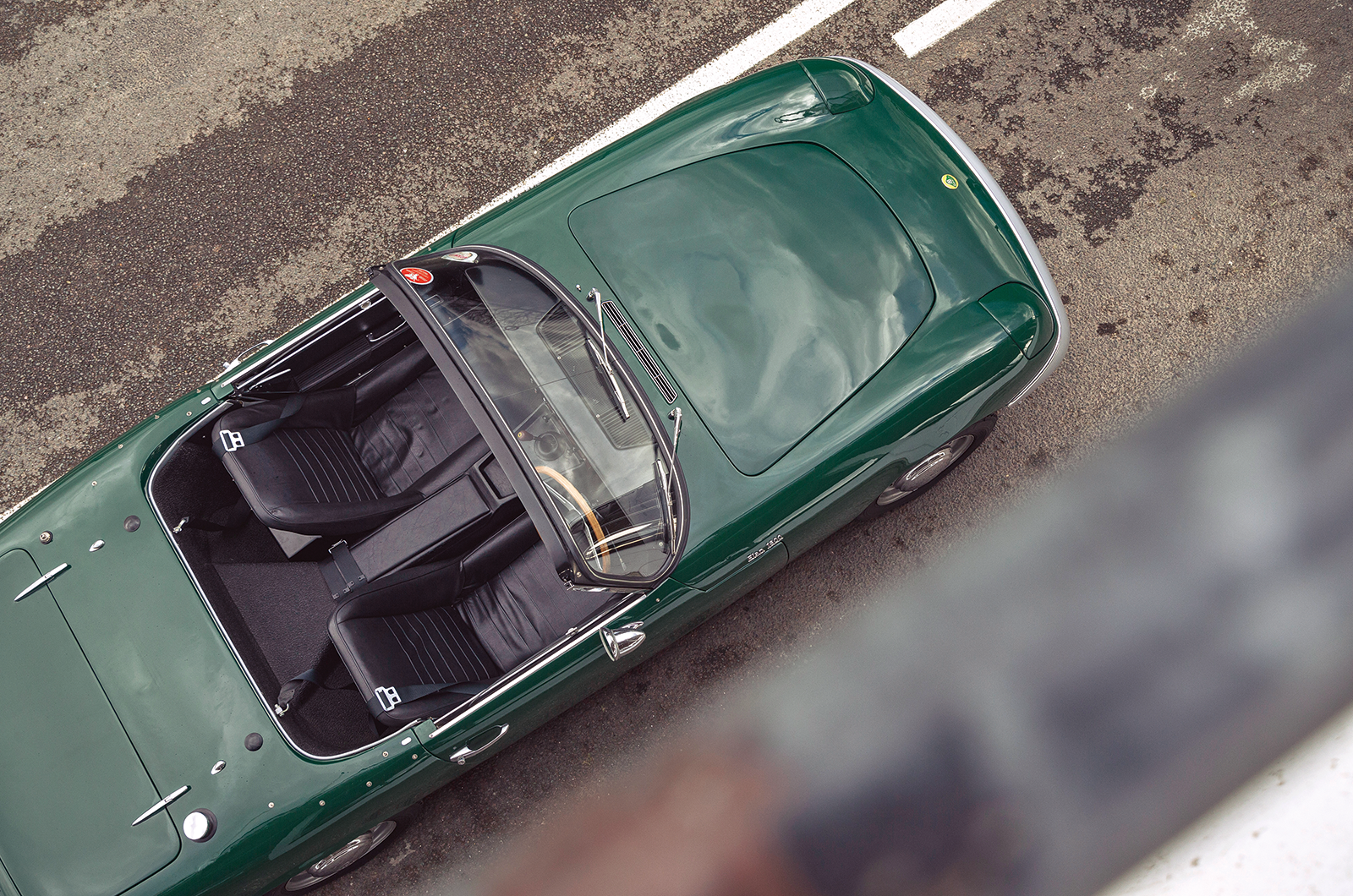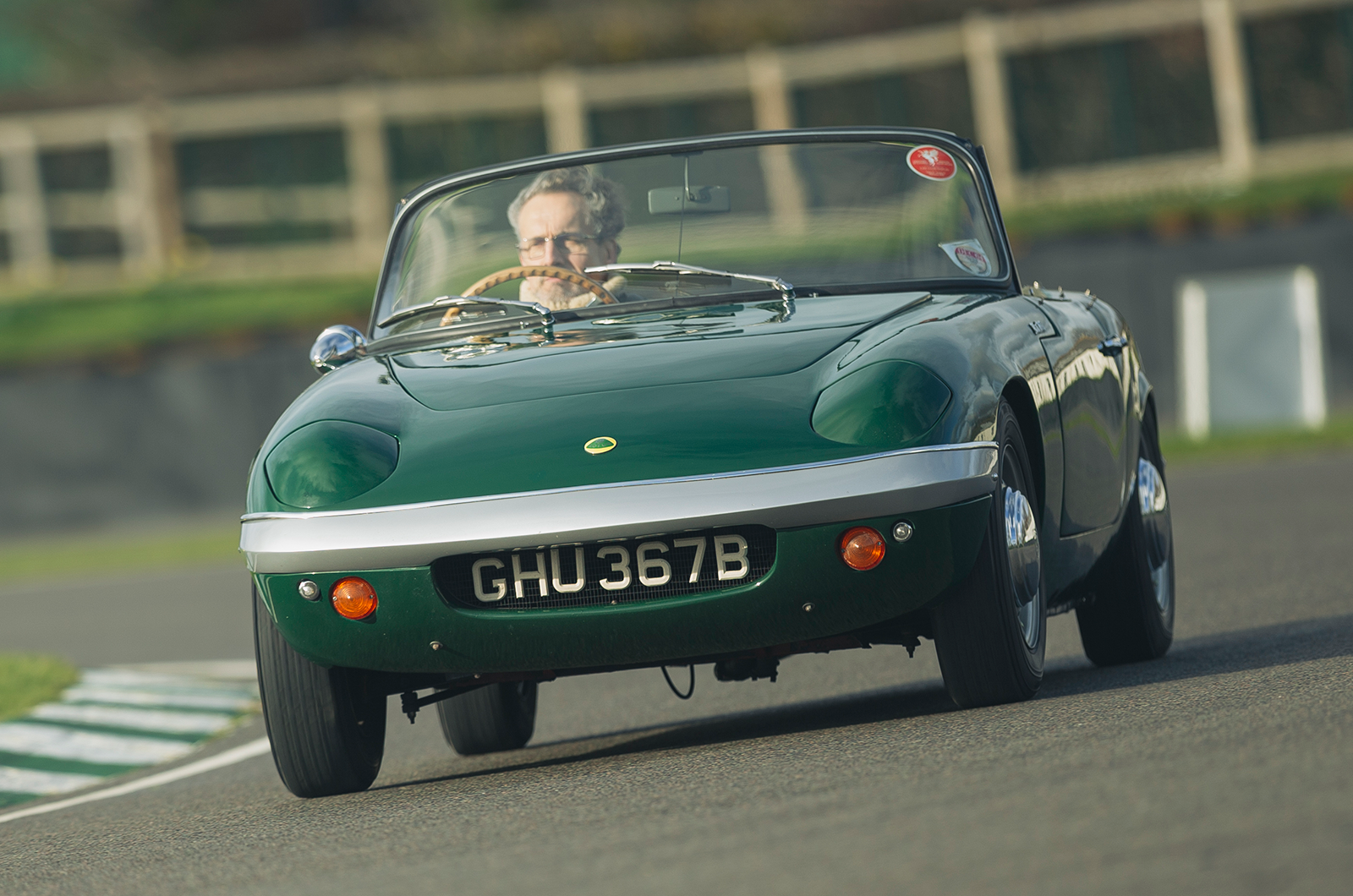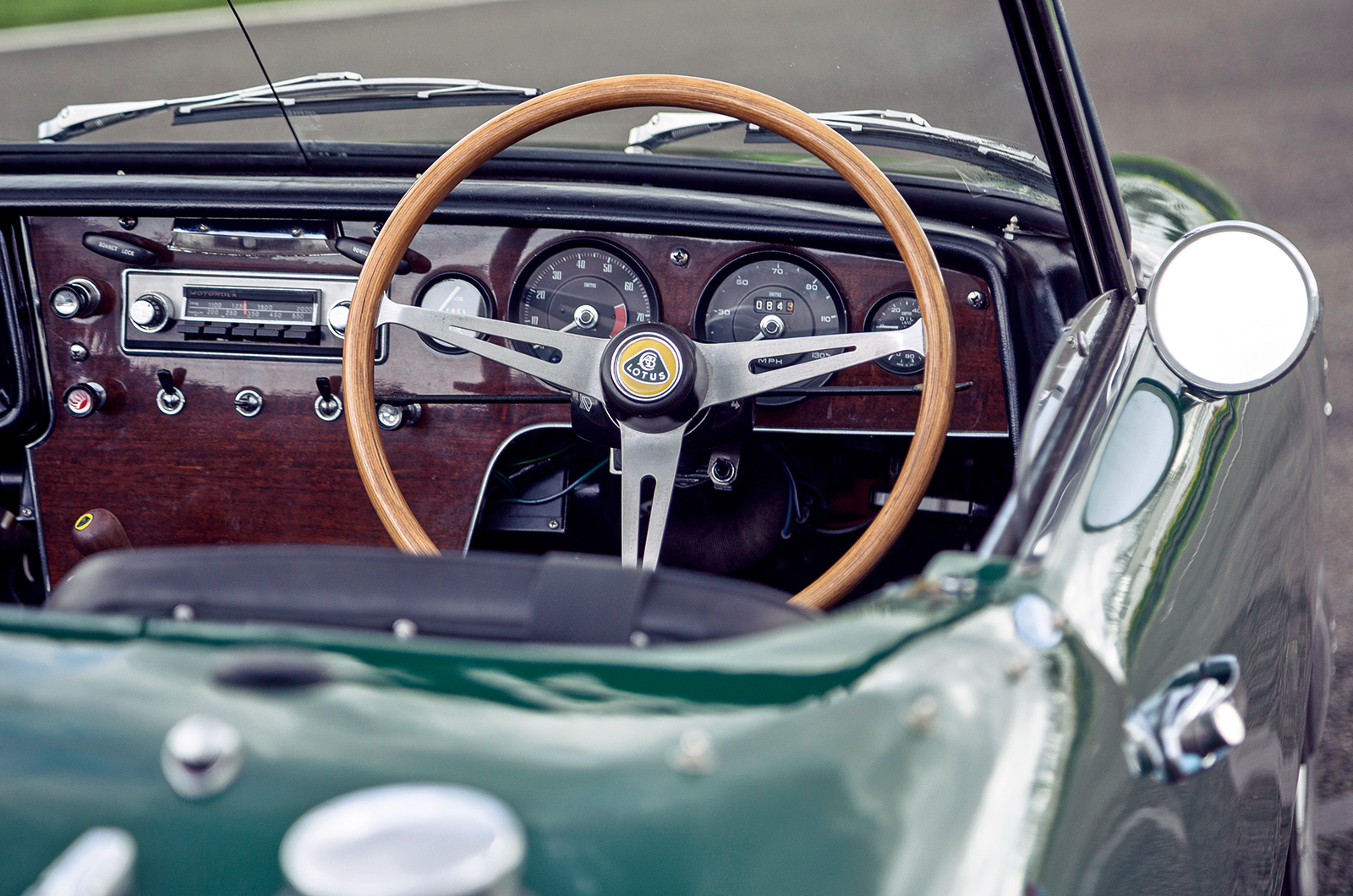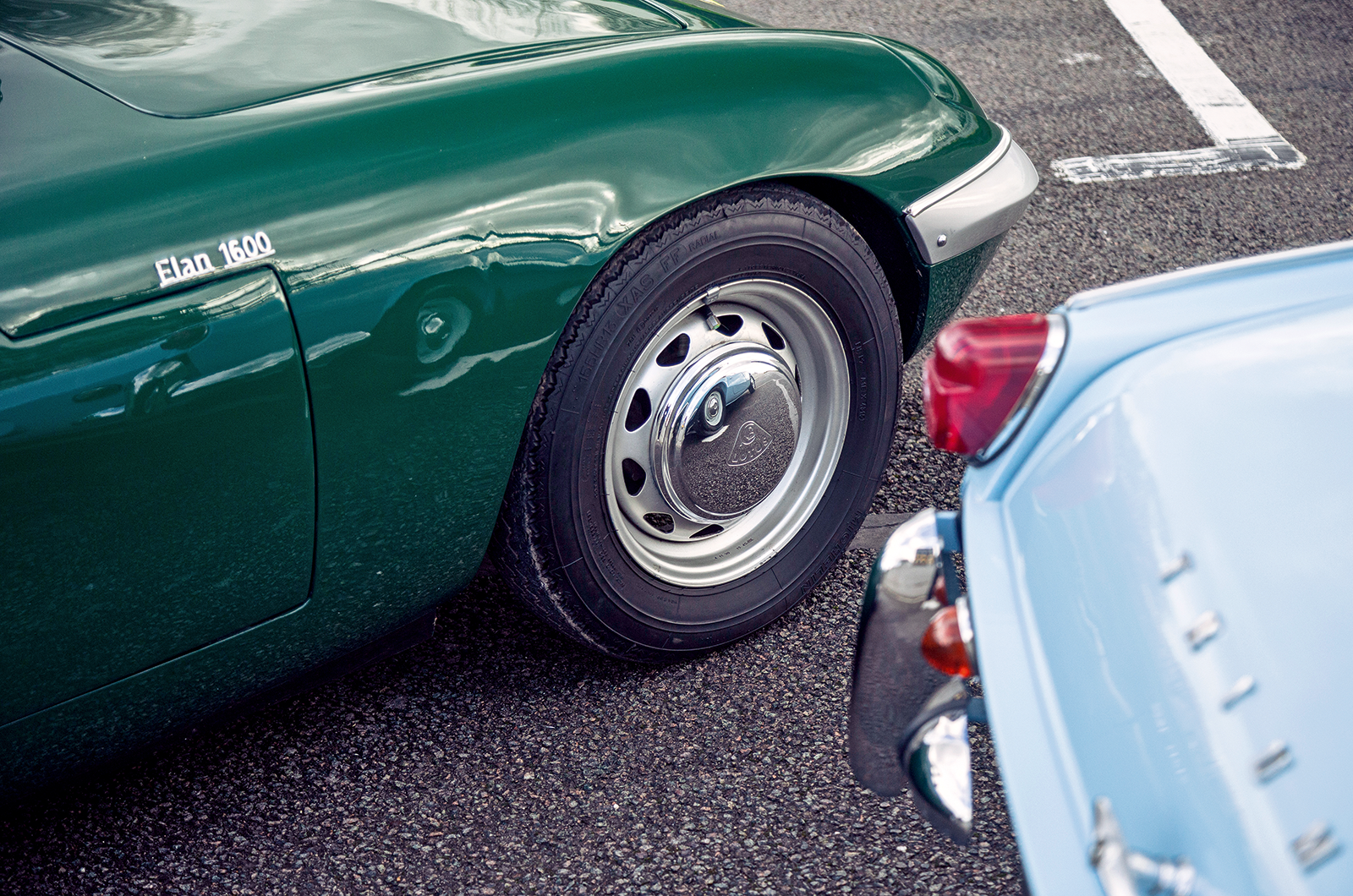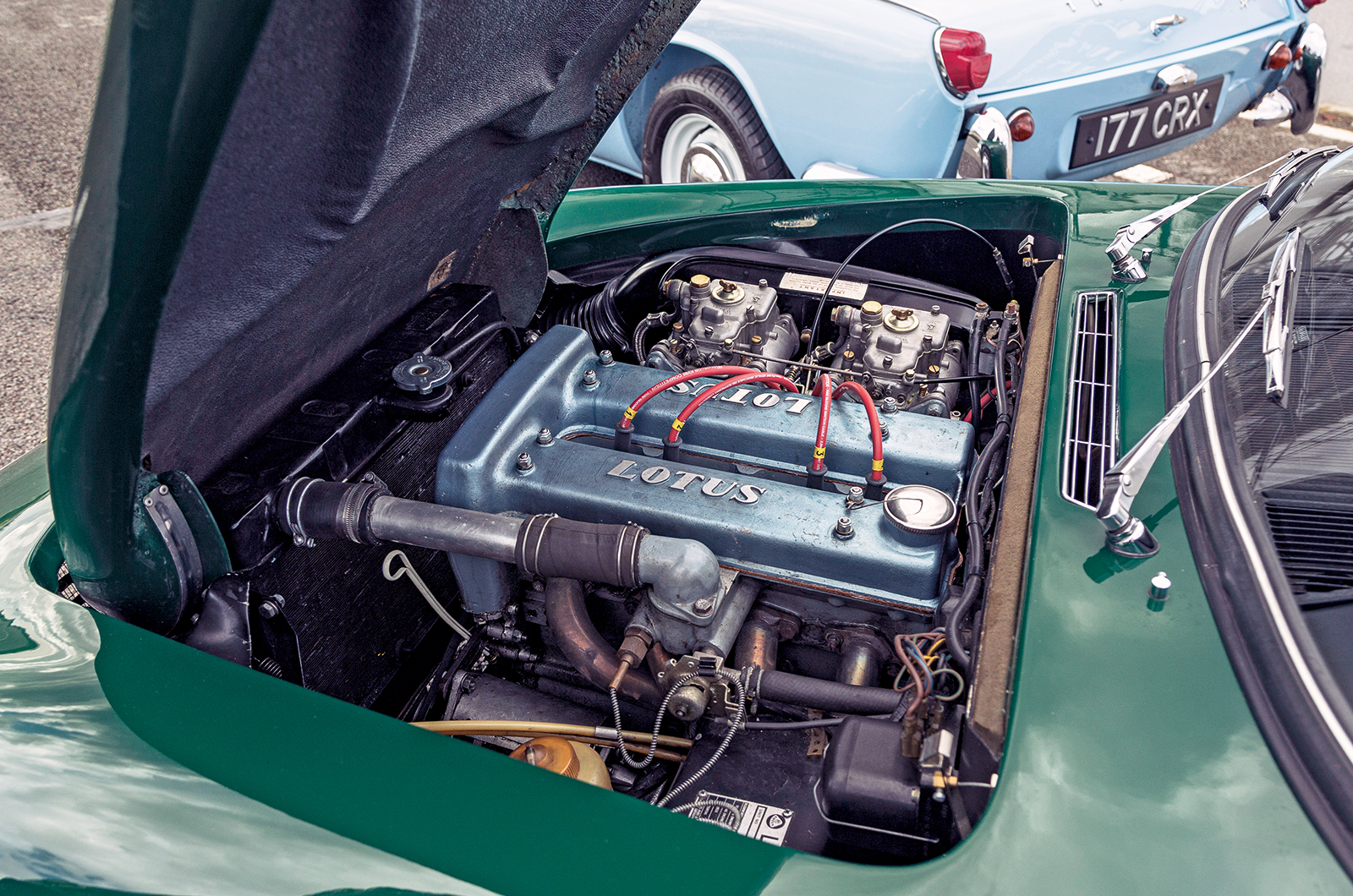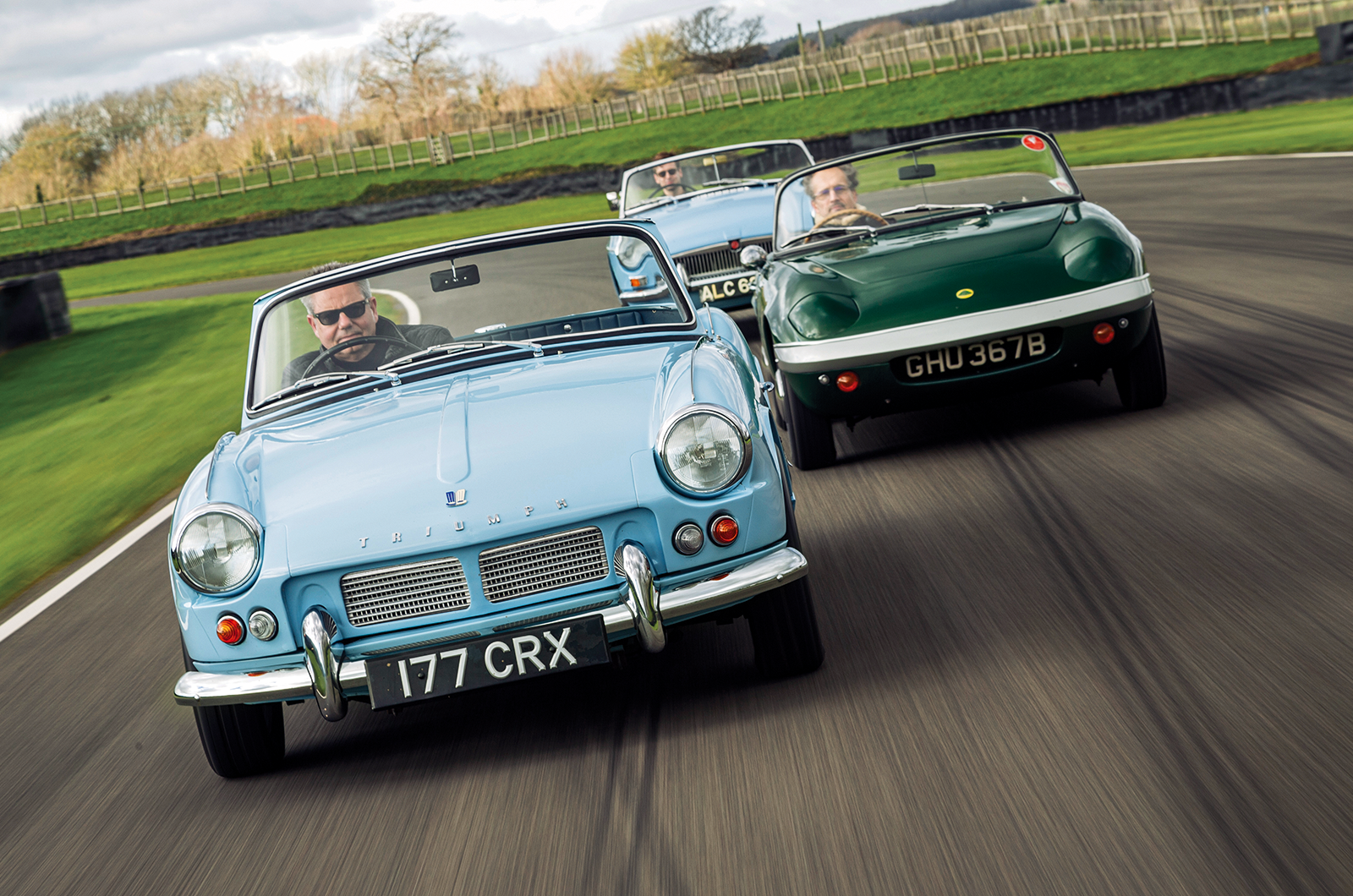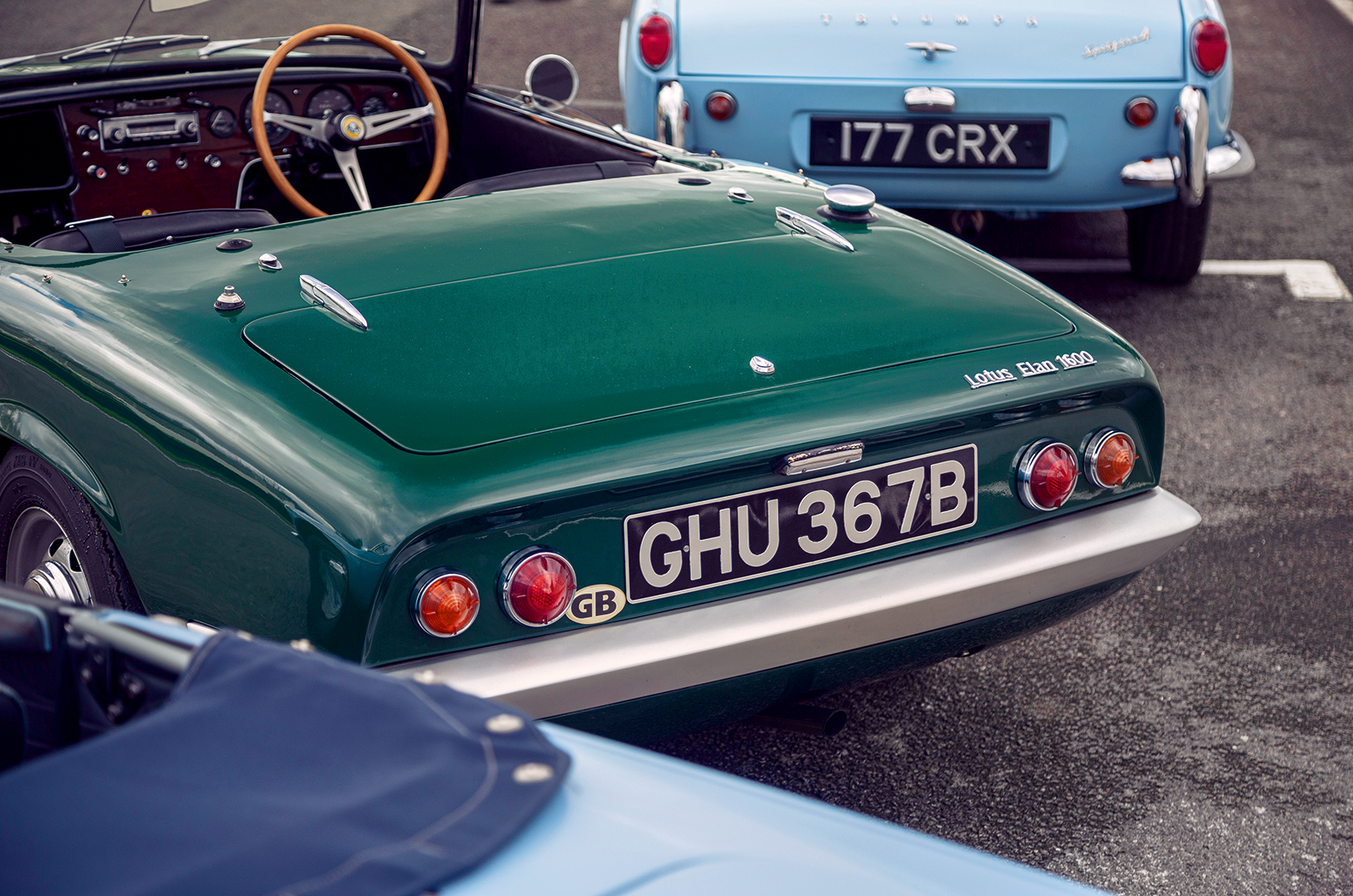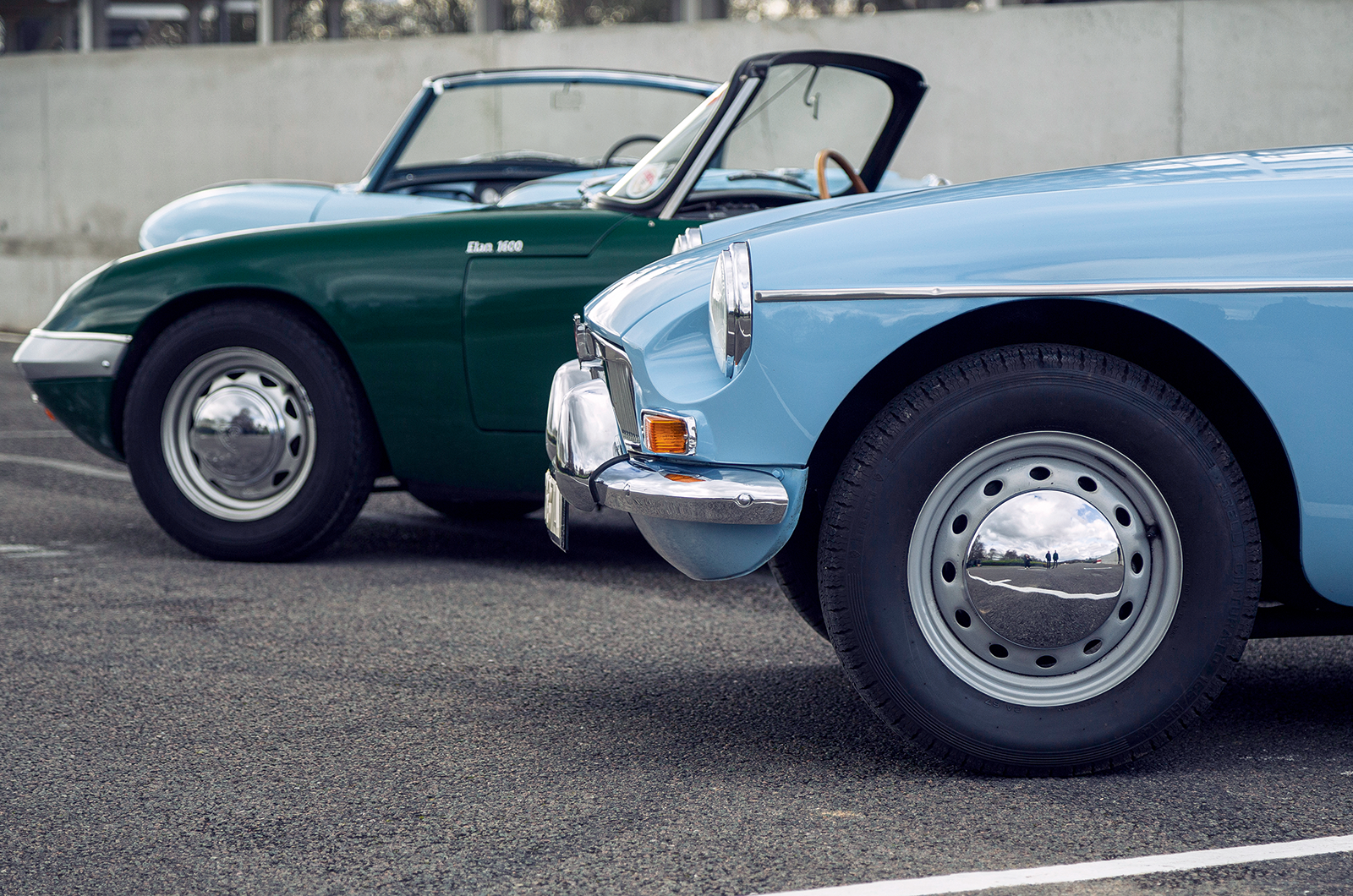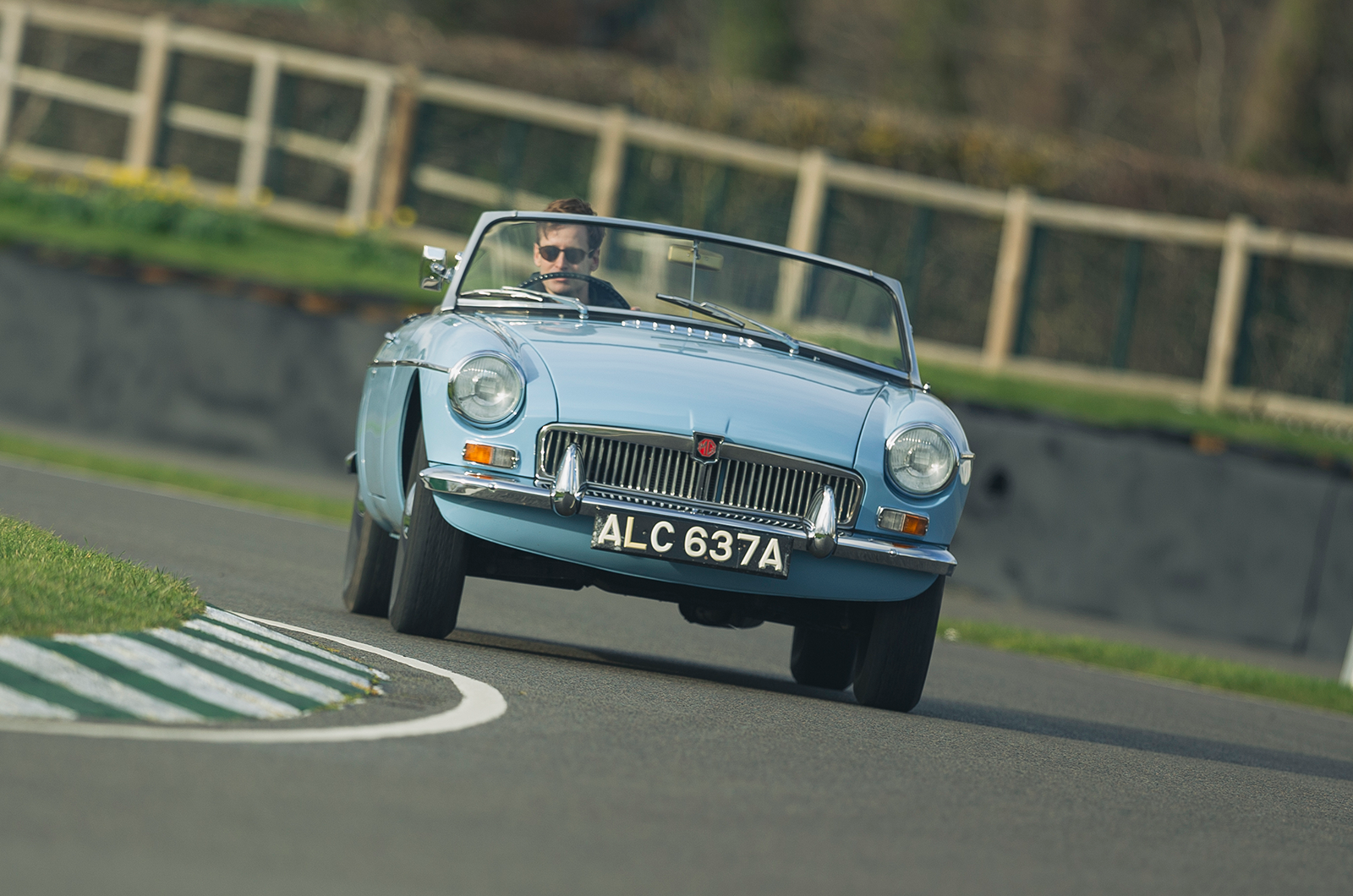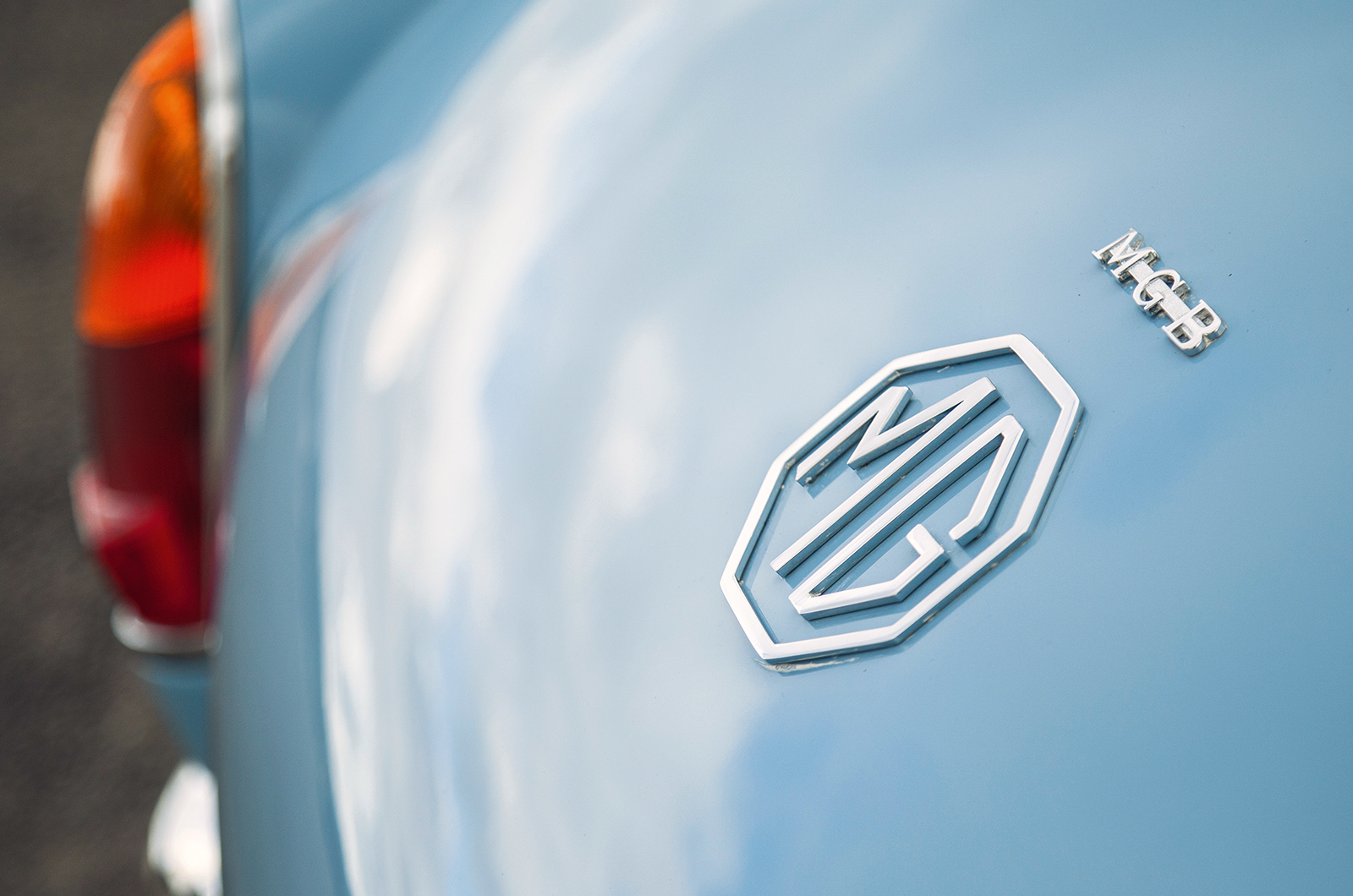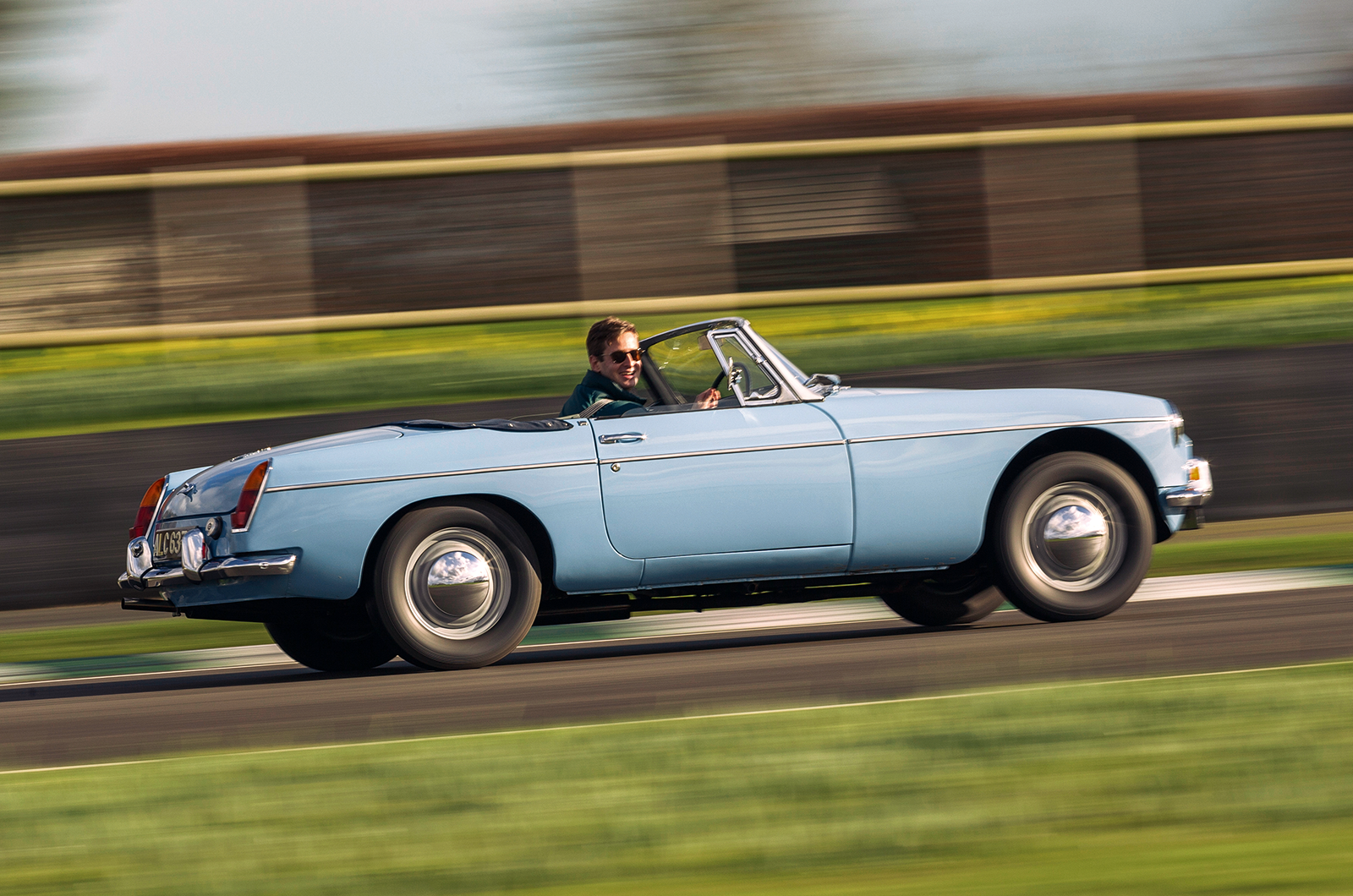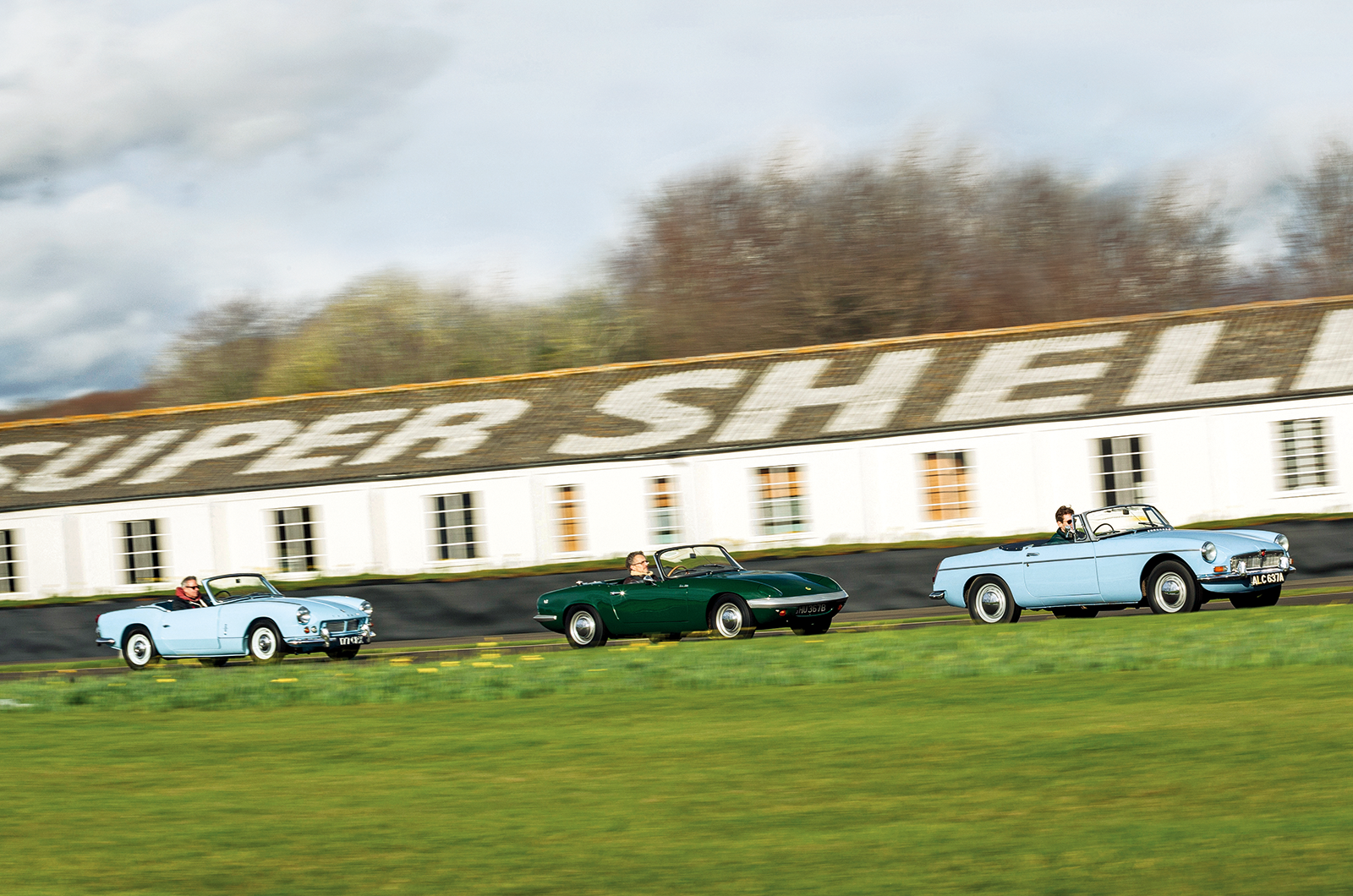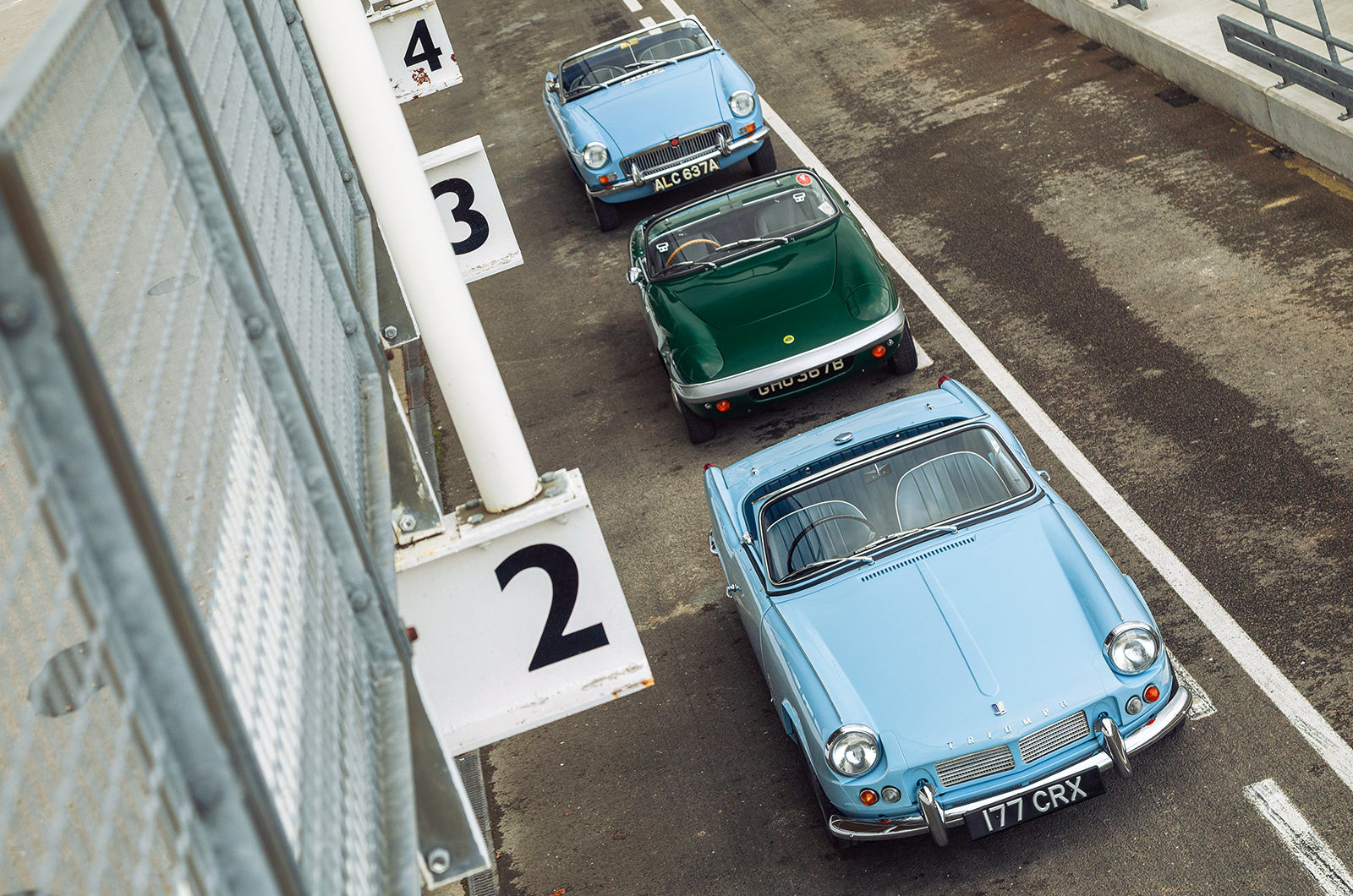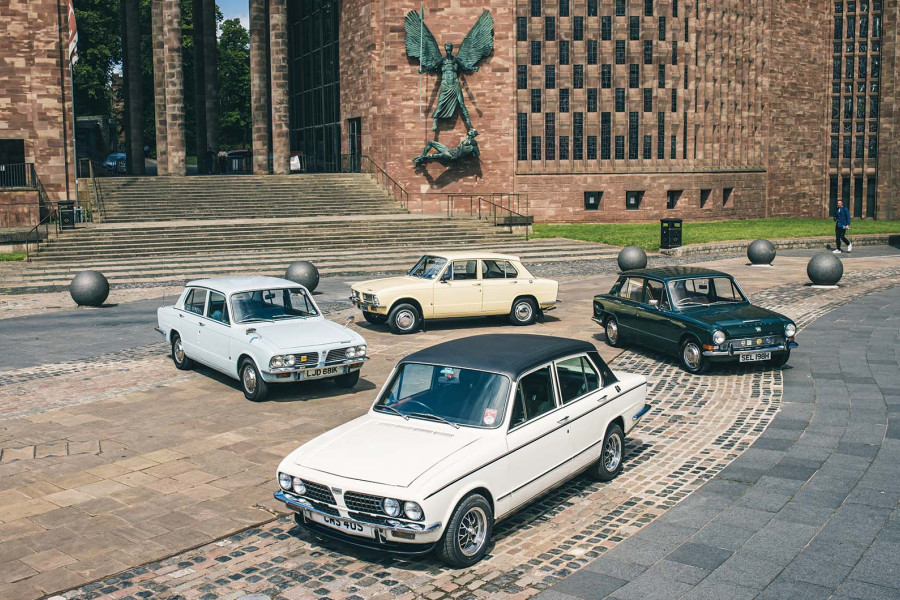Roof down, we blast up the road past Glorious Goodwood’s racecourse, the bark of that Twin Cam becoming truly infectious as the revs grow, with the throaty twin Weber 40s adding to the aural drama.
The Lotus Elan’s Twin Cam engine produces 105bhp
The four-speed Ford ’box is notchy, with a short, positive, mechanical feel – just as well, because you need to keep the engine percolating above 2500rpm for best results.
Body control is tight, ride firm, and the high-geared steering delivers sensational levels of feedback.
Low gearing in top (around 20mph per 1000rpm) is perfect for these twisty South Downs lanes: point-to-point, there would have been few to touch it back in the day.
The MGB (rear) pressures the Spitfire (front) with a huge 43lb ft torque advantage, while the Elan walks away from both thanks to its 153bhp per tonne
So is it a case of half the price, half the thrills with the Triumph?
Jez Woods’ October 1962-built car, chassis FC301, is one of several Spitfires he’s owned since the 1980s.
177 CRX was fully restored by Triumph specialist Jigsaw over a four-year period, and is now resplendent once again in its original Powder Blue livery.
Even by the standards of the early ’60s, the cabin is spartan and copious body-coloured surfaces abound.
Although the Lotus Elan (middle) offers a more sporty ride than the Triumph’s (top), both cars are heaps of fun to drive
The central four-dial binnacle would have minimised production costs between right- and left-hand drive, and the Smiths readouts are the height of clarity.
Pull away and a first-gear whine reveals the car’s Heraldic roots, as does its tiny turning circle (a mere 24ft).
The steering is quite low-geared and, with a fair chunk of free play off-centre, you quickly learn that a light touch is advisable as speeds rise.
But the accelerator demands decisiveness at all times; attempt to pull away on anything less than half-throttle and you kangaroo like an L-plated 17-year-old.
Steel wheels with chrome hubcaps on all three
And then, of course, you need to keep it pinned through faster bends, knowing that a lift – especially on these slightly damp Sussex roads – could mean a camber change through its swing-axles, with an ensuing loss of grip.
But it’s a hoot. The gearshift snicks crisply, and is accompanied by the loudest exhaust note of our trio, making the car feel far faster than its 0-60mph figure (17.3 secs) suggests.
Sure, there’s considerably more body flex versus the Elan, but its fun-factor is undiminished.
The MGB is more of a GT compared to the Lotus and Triumph
That Eann Sutton’s immaculate 1963 MGB offers the biggest contrast to driving the Spitfire and Elan is perhaps no surprise.
Visually, it’s period-accurate, with standard steel rims (wires were optional), pull-doorhandles and a lack of head restraints, and only its colour being from a later series of B.
The engine, too, benefits from a five-bearing crank (as opposed to the earlier three), and what would have been an optional oil cooler.
This classic MGB features a few choice upgrades
Sutton’s car has also been upgraded with a Kenlowe fan and K&N air filters, with an alternator replacing the dynamo.
But the biggest change is a swap from the original, non-overdrive four-speed gearbox to a more modern Ford five-speeder, though the cranked lever you see is unchanged.
The MGB is more like a refined, open-topped GT than out-and-out sports car.
The deep timbre and linear delivery of the B-series give the car an immediate feeling of savoir faire.
The MGB’s well-proportioned body was penned by designer Don Hayter
The non-standard ’box is a joy to use, with a slick, well-oiled feel to every change, but then so was the original, the plain difference being that fifth gear now replaces fourth with overdrive.
You’d look forward to covering long distances in the B.
The steering wheel on this early car is perhaps on the large side of comfortable, but the handling is well balanced and grip ample from its non-original Pirelli radial tyres.
The Triumph Spitfire, Lotus Elan and MGB (left to right) inspired a generation of great sports cars
Vive la difference!
Between them, these cars offered sporting salvation to a broad cross-section of buyers 60 years ago, and their enduring popularity meant long production lives for them all (11 years for the Elan, and 18 years each for the B and Spitfire).
The Lotus and Triumph, it is claimed, even inspired the greatest modern exponent of this era and genre of car: the Mazda MX-5.
That’s some legacy.
Images: Luc Lacey
Thanks to: Jade Callan, Goodwood; Alan Morgan, Club Lotus; Andy Harris, Chichester MGOC; Triumph Sports Six Club
Factfiles
Triumph Spitfire 4
- Sold/number built 1962-’80/314,332 (all variants)
- Construction steel backbone chassis, steel body
- Engine all-iron, ohv 1147cc ‘four’, twin SU carburettors
- Max power 63bhp @ 5750rpm
- Max torque 67lb ft @ 3500rpm
- Transmission four-speed manual, RWD
- Suspension independent, at front by double wishbones, coil springs, anti-roll bar rear swing-axles, transverse leaf spring, radius rods; telescopic dampers f/r
- Steering rack and pinion
- Brakes discs front, drums rear
- Length 12ft 1in (3683mm)
- Width 4ft 1in (1244mm)
- Height 3ft 11½in (1206mm)
- Wheelbase 6ft 11in (2108mm)
- Weight 1589lb (721kg)
- 0-60mph 17.3 secs
- Top speed 92mph
- Mpg 31.2
- Price new £729
- Price now £8-20,000*
Lotus Elan 1600
- Sold/number built 1962-’73/12,224 (all variants)
- Construction steel backbone chassis, glassfibre body and bumpers
- Engine iron-block, alloy-head, dohc 1558cc ‘four’, twin Weber carburettors
- Max power 105bhp @ 5500rpm
- Max torque 108lb ft @ 4000rpm
- Transmission four-speed manual, RWD
- Suspension independent, at front by double wishbones rear Chapman struts, lower wishbones; coil springs, telescopic dampers f/r
- Steering rack and pinion
- Brakes discs
- Length 12ft 1in (3683mm)
- Width 4ft 8in (1422mm)
- Height 3ft 9½in (1155mm)
- Wheelbase 7ft (2133mm)
- Weight 1516lb (688kg)
- 0-60mph 8.7 secs
- Top speed 114mph
- Mpg 27.9
- Price new £1499 (£1095 in component form)
- Price now £25-40,000*
MGB
- Sold/number built 1962-’80/ 523,826 (all variants)
- Construction steel monocoque
- Engine all-iron, ohv 1798cc ‘four’, twin SU carburettors
- Max power 95bhp @ 5400rpm
- Max torque 110lb ft @ 3000rpm
- Transmission four-speed manual, optional overdrive, RWD
- Suspension: front independent, by double wishbones, coil springs rear live axle, semi-elliptic leaf springs; lever dampers f/r
- Steering rack and pinion
- Brakes discs front, drums rear
- Length 12ft 9³⁄₁₆in (3891mm)
- Width 4ft 11⅞in (1521mm)
- Height 4ft 1⅜in (1254mm)
- Wheelbase 7ft 7in (2311mm)
- Weight 2072lb (972kg)
- 0-60mph 12.2 secs
- Top speed 103mph
- Mpg 21.4
- Price new £949
- Price now £8-20,000*
*Prices correct at date of original publication
READ MORE
The Bourne supremacy: BRM’s Lotus Elan
Buyer’s guide: Triumph Spitfire
60 years of the MGB in 30 cars
Simon Hucknall
Simon Hucknall is a senior contributor to Classic & Sports Car
